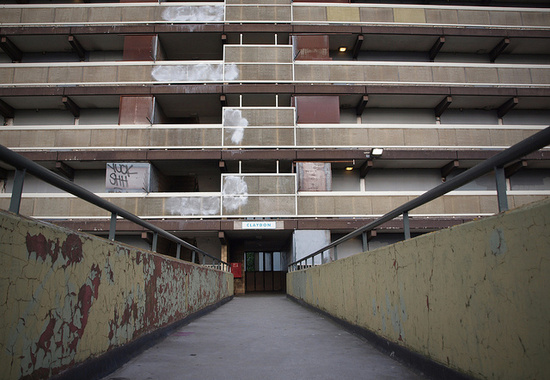Sink estate regeneration plans
Former Prime Minister David Cameron announced new pledges in 2015 to tackle social deprivation and poverty by transforming ‘sink estates’ around the country.
Writing in the Sunday Times on 10 January 2015, Cameron affirmed his intention to deliver a package of measures aimed at radically redeveloping 100 housing estates, replacing them with high-quality homes or in some cases knocking them down altogether.
In what he labelled ‘an all-out assault on poverty and disadvantage’, Cameron said that a new £140 million fund would be set up to enable the regeneration scheme to begin, providing for planning, temporary housing and early construction costs.
A new Estate Regeneration Advisory Panel will be established, chaired by Lord Heseltine, with a deadline to report by this year’s Autumn Statement. Heseltine served in Margaret Thatcher’s government and was the minister responsible for the rejuvenation of Liverpool and London docklands in the 1980s.
The first task of the new panel will be to compile a list of post-war estates that would best benefit from redevelopment. Existing tenants and homeowners have been promised a set of binding guarantees protecting their homes.
Speaking on the Andrew Marr Show, Cameron said that rather than the proposals leading to a decrease in social housing at affordable rents, many more would be built with people being given the chance to buy them via the extended right-to-buy scheme.
In his written article, Cameron highlighted the criminality that has become entrenched and allowed the flourish as a result of the design of some estates, describing ‘brutal high-rise towers and dark alleyways that are a gift to criminals and drug dealers. The police often talk about the importance of designing out crime, but these estates actually designed it in’. He pointed to statistics showing that almost 3-quarters of those convicted after the 2011 riots were inhabitants of such estates.
The PM’s announcement was timed to coincide with a report from property advisor Savills, showing that a new regeneration strategy could serve as the catalyst for hundreds of thousands of new homes being built in London, as well as country-wide.
Yolande Barnes, Savills Research Director, said: “What the Savills research shows is that housing estates can deliver more homes and be made into better neighbourhoods by re-integrating them into the wider street network and creating or repairing the streetscape. This creates more highly valued neighbourhoods.”
You can read David Cameron’s full statement here.
The statement coincided with publication of a Savills Research Report to the Cabinet Office, Completing London’s Streets, How the regeneration and intensification of housing estates could increase London’s supply of homes and benefit residents. This compared two methods of redeveloping social housing estates in London; replacing the existing site with new blocks and towers in a similar layout but higher density (contemporary regeneration) or reintegrating the estates into the surrounding urban fabric (complete streets). They found that the complete streets approach creates greater opportunities for mixed use development and integration into the wider city, resulting in better life chances.
The 17-strong panel was named on 9 February 2016 and included; Jane Duncan, president of the Royal Institute of British Architects (RIBA), Peter Vernon, chief executive of Grosvenor Estates, Councillor Ravi Govindia, leader of Wandsworth Council and Tony Pidgley, chief executive of Berkeley Homes. Ref Gov.uk 9 February.
[edit] Find out more
[edit] Related articles on Designing Buildings Wiki
- Ballymun mass housing and regeneration.
- Brownfield land.
- CIBSE Case Study Thamesmead Estate Refurbishment.
- Enterprise zones.
- Estate Regeneration National Strategy.
- Eyesore.
- Gentrification.
- Housing contribution to regeneration.
- Housing zones.
- Land banking.
- Local development orders.
- Masterplanning.
- Placemaking.
- Regeneration.
- Space, Hope and Brutalism.
- Thamesmead Housing Estate.
- U+I.
- Urban decay.
- Well-being and Regeneration: Reflections from Carpenters Estate.
Featured articles and news
RTPI leader to become new CIOB Chief Executive Officer
Dr Victoria Hills MRTPI, FICE to take over after Caroline Gumble’s departure.
Social and affordable housing, a long term plan for delivery
The “Delivering a Decade of Renewal for Social and Affordable Housing” strategy sets out future path.
A change to adoptive architecture
Effects of global weather warming on architectural detailing, material choice and human interaction.
The proposed publicly owned and backed subsidiary of Homes England, to facilitate new homes.
How big is the problem and what can we do to mitigate the effects?
Overheating guidance and tools for building designers
A number of cool guides to help with the heat.
The UK's Modern Industrial Strategy: A 10 year plan
Previous consultation criticism, current key elements and general support with some persisting reservations.
Building Safety Regulator reforms
New roles, new staff and a new fast track service pave the way for a single construction regulator.
Architectural Technologist CPDs and Communications
CIAT CPD… and how you can do it!
Cooling centres and cool spaces
Managing extreme heat in cities by directing the public to places for heat stress relief and water sources.
Winter gardens: A brief history and warm variations
Extending the season with glass in different forms and terms.
Restoring Great Yarmouth's Winter Gardens
Transforming one of the least sustainable constructions imaginable.
Construction Skills Mission Board launch sector drive
Newly formed government and industry collaboration set strategy for recruiting an additional 100,000 construction workers a year.
New Architects Code comes into effect in September 2025
ARB Architects Code of Conduct and Practice available with ongoing consultation regarding guidance.
Welsh Skills Body (Medr) launches ambitious plan
The new skills body brings together funding and regulation of tertiary education and research for the devolved nation.
Paul Gandy FCIOB announced as next CIOB President
Former Tilbury Douglas CEO takes helm.
UK Infrastructure: A 10 Year Strategy. In brief with reactions
With the National Infrastructure and Service Transformation Authority (NISTA).
























Comments
This building is Grade II* listed and is not on a sink estate - poor choice of image.
Good point, changed accordingly. Thanks for highlighting, Ed.